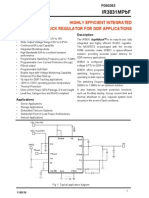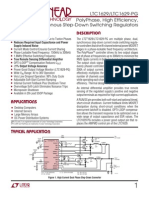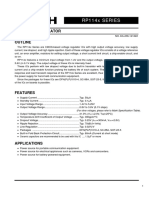Description: Green-Power PWM Controller With Freq. Jiggling
Description: Green-Power PWM Controller With Freq. Jiggling
Uploaded by
Luis GuevaraCopyright:
Available Formats
Description: Green-Power PWM Controller With Freq. Jiggling
Description: Green-Power PWM Controller With Freq. Jiggling
Uploaded by
Luis GuevaraOriginal Title
Copyright
Available Formats
Share this document
Did you find this document useful?
Is this content inappropriate?
Copyright:
Available Formats
Description: Green-Power PWM Controller With Freq. Jiggling
Description: Green-Power PWM Controller With Freq. Jiggling
Uploaded by
Luis GuevaraCopyright:
Available Formats
Page No.
: 1/8
RS2042
Green-Power PWM Controller with Freq. Jiggling
Description
The RS2042 is a low startup current, low cost, current mode PWM controller with Green-Power & Burst-mode power-saving operation. The integrated functions such as the leading-edge blanking of the current sensing, internal slope compensation provide the users a high efficiency, low external component counts, and low cost solution for AC/DC power applications. The special Green-Power function provides off-time modulation to linearly decrease the switching frequency under light-load conditions. And under zero-load conditions, the power supply enters Burst-mode to further reduce power consumption by shutting off PWM output. When the output of power supply is short or over loaded, the FB voltage will increase, and if the FB voltage is higher than 5.2V for longer than 56msec the PWM output will be turned off. A external NTC resistor connected from pin RT to ground can be applied to over-temperature protection. Pulse by pulse current limit ensures a constant output current even under short circuit. PWM output will be disabled as long as VDD exceeds a threshold. When internal latch circuit is used to latch-off the controller, the latch will be reset when the power supply VDD is disabled.
Features
Low Cost, Green-Power Burst-Mode PWM Very Low Start-up Current (about 7.5A) Low Operating Current (about 3.0mA) Current Mode Operation Under Voltage Lockout (UVLO) VDD Over Voltage Protection (OVP) Programmable over-temperature protection Internal Latch Circuit (OTP, OVP) Built-in soft start with 1ms Built-in Frequency Jiggling for better EMI Signature Soft Clamped gate output voltage 16.5V VDD over voltage protect 25.5V Cycle-by-cycle current limiting Sense Fault Protection Output SCP (Short circuit Protection) Built-in Synchronized Slope Compensation Leading-edge blanking on Sense input Programmable PWM Frequency High-Voltage CMOS Process with ESD DIP-8 & SOP-8 Pb-Free Package
Applications
Power Adaptor Battery Charger Adapter Open Frame Switching Power Supply LCD Monitor
Pin Configurations
Name GND FB VIN RI RT SENSE VDD GATE
Description GND Pin Voltage feedback pin. The PWM duty cycle is determined by FB and Sense. This pin is pulled high to the rectified line input through a large resistor for start-up. This pin is also used to detect line voltage to compensate for constant output power limit for universal AC input. By connecting a resistor to ground to set the switching freq.. Increasing the resistor will reduce the switching freq.. An NTC resistor is connected from this pin to ground for over-temperature protection. Current sense pin, The sensed voltage is used for current-mode control and pulse-by-pulse current limiting. Power supply voltage pin. Gate drive output to drive the external MOSFET. A soft driving waveform is implemented to improve EMI.
DS-RS2042-03
Dec, 2008
www.Orister.com
Page No. : 2/8
Typical Application Circuit
From bridge rectifier
From auxiliary winding
1 2 3 4
GND FB VIN RI
GATE VDD SENSE RT
8 7 6
Rs
5
NTC
Block Diagram
RI VIN
0.9V Current Reference VDD
Soft Driver
GATE
RT
OTP
PWM LATCH
Internal BIAS
OSC
S R
Blanking Circuit
SENSE
Slope Compensation
VDD
UVLO
OVP Burst Mode Controller Green Mode Controller
56ms Debounce
FB
5.2V
GND
DS-RS2042-03
Dec, 2008
www.Orister.com
Page No. : 3/8
Absolute Maximum Ratings
Symbol VDD VFB VSense PD Parameter Supply voltage Pin Voltage Input Voltage to FB Pin Input Voltage to SENSE Pin Power Dissipation ESD Capability, HBM Model ESD Capability, Machine Model DIP-810sec Lead Temperature (Soldering) SOP-810sec Storage Temperature Range Range 40 -0.3 to 6V -0.3 to 6V 1000 2000 200 260 230 -55 to + 150 Units V V V mW V V
o o
TL TSTG
C C
Electrical Characteristics (Ta=27C unless otherwise noted, VDD = 15V.)
Symbol Parameter Test Conditions RS2042 Min Typ Max Unit
IST ISS VTH (ON) VTH (OFF) VDD-OVP VDD-th-g IFB VFB VTH TPD ZCS Bnk VTH FOSC FOSC-green VN VG
VOL VOH TR TF DCMAX IRT VOTP RINOR RIMAX RIMIN
Supply Voltage (VDD Pin) Startup Current VDD=17 Operating Current VFB= VSENSE = 0V, VDD=15 Start Threshold Voltage -Min. Operating Voltage -VDD Over Voltage Protection (Latch off) VDD Low-Threshold Voltage to Exit Green-OFF Mode Voltage Feedback (FB Pin) Short Circuit Current VFB=0V Open Loop Voltage VFB=Open Current Sensing (SEN Pin) Threshold voltage for current limit IVIN =0 Delay to Output Input Impedance Leading Edge Blanking Time Threshold voltage for current limit IVIN =0 Oscillator (RI Pin) Frequency in nominal mode RI=26K Frequency in green mode RI=26 K Beginning of frequency reducing at FB Voltage VDD=15V End of frequency reducing at FB voltage VDD=15V Frequency Temp. Stability -30-85oC GATE Drive Output (GATE Pin) Output Low Level VDD=12V, IO=50mA Output High Level VDD=12V, IO=50mA Rising Time VDD=15V, CL=1nF Falling Time VDD=13V, CL=1nF Maximum Duty Cycle Over-Temperature Protection Section Output current of pin RT RI=26K Threshold voltage for over-temperature protection. RI Section RI Operating Range Max RI value for Protection
16.0 10.4 23.0 11.0
7.5 3.0 16.5 10.8 24.5 12.0
30 5 17.0 11.2 25.0 13.0 1.42
A mA V V V V mA V V nsec K nsec V KHz KHz V VG % V V ns ns % A V K K K
6.00 0.76 115 13 354 0.76 67 27 2.05 1.54 5.0 0.32 8.00 240 80 86 70 1.05 26 216 6 0.9 200 460 0.9 70 29 2.15 1.60
260
63 25 1.95 1.50
0.60 280 90 88 75 1.10 36
7.2 200 30 84 65 1.00 15.5
DS-RS2042-03
Dec, 2008
www.Orister.com
Page No. : 4/8
OPERATION DESCRIPTION
Start-Up Current & Operating Current
The typical start-up current is only 8A. This allows a high resistance, low-wattage start-up resistor to be used, to minimize power loss. A 1.5MOhms, 0.25W, start-up resistor and a 10F/40V VDD hold-up capacitor would be sufficient for an AC/DC adapter with a universal input range. The required operating current has been reduced to 3.4mA. This results in higher efficiency and reduces the VDD hold-up capacitance requirement.
Green-Power Mode Operation
The proprietary green-power mode function provides off-time modulation to continuously decrease the PWM frequency under light-load conditions. To avoid acoustic-noise problem, the minimum PWM frequency set above 25KHz. This green-power mode function dramatically reduces power consumption under light-load and zero-load conditions. Power supplies using a RS2042 controller can easily meet even the most restrictive international regulations regarding standby power consumption.
Oscillator Operation
A resistor connected from the RI pin to GND pin generates a constant current source for the RS2042 controller. This current is used to determine the center PWM frequency. Increasing the resistance will reduce PWM frequency. Using a 26K resistor RI results in a corresponding 67KHz PWM frequency. The relationship between RI and the switching frequency is:
f PWM
1742 ( KHz ) R I ( K )
RS2042 also integrates frequency Jiggling function internally. The frequency variation ranges from around 63KHz to 70KHz for a center frequency 67kHz. The frequency jittering function helps reduce EMI emission of a power supply with minimum line filters.
I RT
Leading Edge Blanking
70A * 26 R I ( K )
Each time the power MOSFET is switched on, a turn-on spike will inevitably occur at the sense-resistor. To avoid premature termination of the switching pulse, a leading-edge blanking time is built in. During this blanking period, the current-limit comparator is disabled, and it cannot switch off the gate drive.
Under-Voltage Lockout (UVLO)
The turn-on/turn-off thresholds are fixed internally at 12.4V/16.5V. To enable a RS2042 controller during start-up, the hold-up capacitor must first be charged to 16.5V through the start-up resistor. The hold-up capacitor will continue to supply VDD before energy can be delivered from the auxiliary winding of the main transformer. VDD must not drop below 12.4V during this start-up process. This UVLO hysteresis window ensures that the hold-up capacitor can adequately supply VDD during start-up.
Gate Output / Soft Driving
The RS2042 output stage is a fast totem pole gate driver. Cross-conduction has been avoided to minimize heat dissipation, increase efficiency, and enhance reliability. The output driver is clamped by an internal 18V Zener diode in order to protect the power MOSFET transistors from any harmful over-voltage gate signals. A soft driving waveform is implemented to minimize EMI.
DS-RS2042-03 Dec, 2008 www.Orister.com
Page No. : 5/8
Slope Compensation
The sensed voltage across the current sense resistor is used for peak-current-mode control and cycle-by-cycle current limiting. The built-in slope compensation function improves power supply stability and prevents peakcurrent-mode control from causing sub-harmonic oscillations. Within every switching cycle, the RS2042 controller produces a positively sloped, synchronized ramp signal.
Constant Output Power Limit
When the SENSE voltage across the sense resistor RS reaches the threshold voltage, the output GATE drive will be turned off following a small propagation delay TPD. This propagation delay will result in an additional current proportional to TPD*VIN/LP. The propagation delay is nearly constant regardless of the input line voltage VIN. Higher input line voltages will result in larger additional currents. Thus, under high input-line voltages the output power limit will be higher than under low input-line voltages. The output power limit variation can be significant over a wide range of AC input voltages. To compensate for this, the threshold voltage is adjusted by the current IIN. Since the pin VIN is connected to the rectified input line voltage through the start-up resistor, a higher line voltage will result in a higher current IIN through the pin VIN. The threshold voltage decreases if the current IIN increases. A small threshold voltage will force the output GATE drive to terminate earlier, thus reducing total PWM turn-on time, and making the output power equal to that of the low line input. This proprietary internal compensation feature ensures a constant output power limit over a wide range of AC input voltages (90VAC to 264VAC).
VDD Over-voltage Protection
VDD over-voltage protection has been built in to prevent damage due to over voltage conditions. When the voltage VDD exceeds the internal threshold due to abnormal conditions, PWM output will be turned off. Over-voltage conditions are usually caused by open feedback loops.
Limited Power Control
The FB voltage will increase every time the output of the power supply is shorted or over-loaded. If the FB voltage remains higher than a built-in threshold for longer than TLPS, PWM output will then be turned off. As PWM output is turned off, the supply voltage VDD will also begin decreasing. When VDD goes below the turn-off threshold (eg, 12.4V) the controller will be totally shut down. VDD will be charged up to the turn-on threshold voltage of 16.5V through the start-up resistor until PWM output is restarted. This protection feature will continue to be activated as long as the over-loading condition persists. This will prevent the power supply from overheating due to over loading conditions.
Thermal Protection
An external NTC thermistor can be connected from the RT pin to ground. A fixed current IRT is sourced from the RT pin. Because the impedance of the NTC will decrease at high temperatures, when the voltage of the RT pin drops below 1.065V, PWM output will be disabled. The RT pin output current is related to the PWM frequency programming resistor RI
Noise Immunity
Noise from the current sense or the control signal may cause significant pulse width jitter, particularly in continuousconduction mode. Slope compensation helps alleviate this problem. Good placement and layout practices should be followed. The designer should avoiding long PCB traces and component leads. Compensation and filter components should be located near the RS2042. Finally, increasing the power-MOS gate resistance is advised.
DS-RS2042-03
Dec, 2008
www.Orister.com
Page No. : 6/8
DIP-8L Dimension
DIM
8 7 6 5
Min. 6.29 9.22 3.25 3.17 0.38 2.28 7.49 8.56 0.229 o 94
Max. 6.40 9.32 *1.52 *1.27 *0.99 3.35 3.55 0.53 2.79 7.74 *3.00 8.81 0.381 o 97
A
1 2 3 4
B C D E
B F
F G H I J K L M
E D
G H
1 K
M L
I
8-Lead DIP-8 Plastic Package Package Code: P
*: Typical, Unit: mm
SOP-8L Dimension
A G
DIM A B C D E F G H I J K L M N O Min. 4.85 3.85 5.80 1.22 0.37 3.74 1.45 4.80 0.05 0.30 0.19 0.37 0.23 0.08 0.00 Max. 5.10 3.95 6.20 1.32 0.47 3.88 1.65 5.10 0.20 0.70 0.25 0.52 0.28 0.13 0.15
8 B
5 C 4 J H
Pin1 Index
E
Part A
K L N O
Part A
*: Typical, Unit: mm
F
8-Lead SO-8 Plastic Surface Mounted Package Package Code: S
Ordering Information
PART NUMBER RS2042P RS2042S PIN-PACKAGE DIP-8L SOP-8L
DS-RS2042-03
Dec, 2008
www.Orister.com
Page No. : 7/8
Soldering Methods for Oristers Products
1. Storage environment: Temperature=10oC~35oC Humidity=65%15% 2. Reflow soldering of surface-mount devices Figure 1: Temperature profile
tP TP Ramp-up TL Tsmax Temperature tL Critical Zone TL to TP
Tsmin tS Preheat
Ramp-down
25
t 25oC to Peak Time
Profile Feature Average ramp-up rate (TL to TP) Preheat - Temperature Min (Tsmin) - Temperature Max (Tsmax) - Time (min to max) (ts) Tsmax to TL - Ramp-up Rate Time maintained above: - Temperature (TL) - Time (tL) Peak Temperature (TP) Time within 5oC of actual Peak Temperature (tP) Ramp-down Rate Time 25oC to Peak Temperature 3. Flow (wave) soldering (solder dipping) Products Pb devices. Pb-Free devices.
Sn-Pb Eutectic Assembly <3oC/sec 100oC 150oC 60~120 sec <3oC/sec 183oC 60~150 sec 240oC +0/-5oC 10~30 sec <6oC/sec <6 minutes
Pb-Free Assembly <3oC/sec 150oC 200oC 60~180 sec <3oC/sec 217oC 60~150 sec 260oC +0/-5oC 20~40 sec <6oC/sec <8 minutes
Peak temperature 245 C 5 C 260 C +0/-5 C
o o o o
Dipping time 5sec 1sec 5sec 1sec
DS-RS2042-03
Dec, 2008
www.Orister.com
Page No. : 8/8
Important Notice:
All rights are reserved. Reproduction in whole or in part is prohibited without the prior written approval of Orister Corporation. Orister Corporation reserves the right to make changes to its products without notice. Orister Corporation products are not warranted to be suitable for use in Life-Support Applications, or systems. Orister Corporation assumes no liability for any consequence of customer product design, infringement of patents, or application assistance.
DS-RS2042-03
Dec, 2008
www.Orister.com
You might also like
- Service Manual: Model SeriesDocument48 pagesService Manual: Model SeriesEnrique Herrera100% (1)
- MCAT Review Physics Notes (Selected)Document38 pagesMCAT Review Physics Notes (Selected)Chris_Barber09100% (2)
- Craig - 4353 TX CobraDocument3 pagesCraig - 4353 TX CobraJorge ContrerasNo ratings yet
- SG 6841 TDocument14 pagesSG 6841 TBayron Salazar SaborioNo ratings yet
- Pt1806 by PTCDocument10 pagesPt1806 by PTCtolomeo10No ratings yet
- Aerosemi: Features ApplicationsDocument9 pagesAerosemi: Features Applicationsttnaing100% (1)
- OB2269Document12 pagesOB2269Juan Ballon100% (1)
- DM0265Document19 pagesDM0265liberthNo ratings yet
- MP3389 r1.04Document16 pagesMP3389 r1.04Andres Alegria100% (1)
- High Efficiency Low-Side N-Channel Controller For Switching RegulatorsDocument33 pagesHigh Efficiency Low-Side N-Channel Controller For Switching Regulatorssoft4gsmNo ratings yet
- DatasheetDocument13 pagesDatasheetkishore kumarNo ratings yet
- LM2727/LM2737 N-Channel FET Synchronous Buck Regulator Controller For Low Output VoltagesDocument22 pagesLM2727/LM2737 N-Channel FET Synchronous Buck Regulator Controller For Low Output VoltagesselocaNo ratings yet
- STCC05-B: Home Appliance Control CircuitDocument13 pagesSTCC05-B: Home Appliance Control Circuitsvhanu4010No ratings yet
- Richtek RT7247ADocument15 pagesRichtek RT7247Ajhg-crackmeNo ratings yet
- Ir3831m PDFDocument31 pagesIr3831m PDFFauzan Akbar SahriNo ratings yet
- Viper20/Sp/Dip Viper20A/Asp/Adip: Smps Primary I.CDocument21 pagesViper20/Sp/Dip Viper20A/Asp/Adip: Smps Primary I.CMilorad RumenicNo ratings yet
- HV7802 14068Document6 pagesHV7802 14068Djzedamendoa Jose LopesNo ratings yet
- Aajfk Sg6859aDocument13 pagesAajfk Sg6859azarevgNo ratings yet
- LM3530 High Efficiency White LED Driver With Programmable Ambient Light Sensing Capability and I C-Compatible InterfaceDocument45 pagesLM3530 High Efficiency White LED Driver With Programmable Ambient Light Sensing Capability and I C-Compatible Interfacethoth2487No ratings yet
- Viper 20 SPDocument22 pagesViper 20 SPgotcha75No ratings yet
- Fan 7392NDocument18 pagesFan 7392NKhaleel MohammadNo ratings yet
- Pam8403 PDFDocument11 pagesPam8403 PDFShahzad RafiqNo ratings yet
- lx1692 PDFDocument15 pageslx1692 PDFvideosonNo ratings yet
- Ltc1629/Ltc1629-Pg Polyphase, High Efficiency, Synchronous Step-Down Switching RegulatorsDocument28 pagesLtc1629/Ltc1629-Pg Polyphase, High Efficiency, Synchronous Step-Down Switching Regulatorscatsoithahuong84No ratings yet
- IC-ON-LINE - CN dm0465r 44841Document20 pagesIC-ON-LINE - CN dm0465r 44841ubhagavanNo ratings yet
- 10884Document13 pages10884karthikeidNo ratings yet
- cr6853 Chip-RailDocument12 pagescr6853 Chip-RailJosé Edilson da PazNo ratings yet
- U708Document28 pagesU708Sol De GabrielNo ratings yet
- Ncl30160 1.0A Constant-Current Buck Regulator For Driving High Power LedsDocument10 pagesNcl30160 1.0A Constant-Current Buck Regulator For Driving High Power LedsKhúc Hành QuânNo ratings yet
- Tl082cp Datasheet de National Semiconductor para Sustituir Ci de Etapa Pre Amplificador Bunker Mx2400 2Document12 pagesTl082cp Datasheet de National Semiconductor para Sustituir Ci de Etapa Pre Amplificador Bunker Mx2400 2Jess AJNo ratings yet
- Fan 7314Document14 pagesFan 7314Kamal NonekNo ratings yet
- Fan7340 Slc1012c PWM Backlight Samsung 32Document16 pagesFan7340 Slc1012c PWM Backlight Samsung 32Andres Alegria50% (4)
- Datasheet PDFDocument32 pagesDatasheet PDFMochamad AlbiNo ratings yet
- 3A, 24V Asynchronous Step Down DC/DC Converter: Description FeaturesDocument10 pages3A, 24V Asynchronous Step Down DC/DC Converter: Description FeaturesMax NiNo ratings yet
- ME8204 MicroneDocument12 pagesME8204 Micronemartin.recmanNo ratings yet
- 700ma H V A C R W E C: IGH Oltage Djustable Urrent Egulator ITH Nable OntrolDocument6 pages700ma H V A C R W E C: IGH Oltage Djustable Urrent Egulator ITH Nable OntrolNathan WilliamsNo ratings yet
- PWM Control 1A Step-Down Converter Data Sheet: TM Technology IncDocument12 pagesPWM Control 1A Step-Down Converter Data Sheet: TM Technology IncselocaNo ratings yet
- Current Mode PWM Controller With Frequency Shuffling ME8202Document12 pagesCurrent Mode PWM Controller With Frequency Shuffling ME8202Kukla LossNo ratings yet
- FSDH0265RN, FSDM0265RN: Green Mode Fairchild Power Switch (FPS)Document20 pagesFSDH0265RN, FSDM0265RN: Green Mode Fairchild Power Switch (FPS)Wsad WsadNo ratings yet
- Pam8610 PDFDocument15 pagesPam8610 PDFRaka Satria PradanaNo ratings yet
- Iso122sensor de TensionDocument15 pagesIso122sensor de TensionRichard ZerpaNo ratings yet
- 5V-0.5A Very Low Drop Regulator With Reset: DescriptionDocument6 pages5V-0.5A Very Low Drop Regulator With Reset: DescriptionDan EsentherNo ratings yet
- R1218x SERIES: Step-Up DC/DC Converter For White LED BacklightDocument21 pagesR1218x SERIES: Step-Up DC/DC Converter For White LED Backlight666667No ratings yet
- Vishay Siliconix: FeaturesDocument11 pagesVishay Siliconix: Featuresxyh666No ratings yet
- Off-Line Quasi-Resonant Switching Regulators: STR-X6769Document9 pagesOff-Line Quasi-Resonant Switching Regulators: STR-X6769Alfredo Valencia RodriguezNo ratings yet
- PT4115 89eDocument15 pagesPT4115 89eAnonymous aDAfzvNo ratings yet
- PT1301Document9 pagesPT1301dcastrelos2000No ratings yet
- IC-ON-LINE - CN dm0365r 44840Document20 pagesIC-ON-LINE - CN dm0365r 44840MoscandoNo ratings yet
- SPPL12420RH1Document11 pagesSPPL12420RH1essen999No ratings yet
- 20 W 2-Channel BTL AF Power Amplifier For Car Stereos: SANYO Electric Co.,Ltd. Semiconductor Bussiness HeadquartersDocument9 pages20 W 2-Channel BTL AF Power Amplifier For Car Stereos: SANYO Electric Co.,Ltd. Semiconductor Bussiness Headquartersfernandes66No ratings yet
- Low Cost Green-Power PWM Controller With Low EMI Technique FeaturesDocument12 pagesLow Cost Green-Power PWM Controller With Low EMI Technique FeaturesRogeriomgoNo ratings yet
- ADocument17 pagesAWillian CristianoNo ratings yet
- Datasheet PDFDocument45 pagesDatasheet PDFSonidos SotoNo ratings yet
- Fan 6961Document13 pagesFan 6961Ariel NavarreteNo ratings yet
- Feature General Description: HT7A6005 Low Power, Wide Temperature Range General Purpose Current Mode PWM ControllerDocument11 pagesFeature General Description: HT7A6005 Low Power, Wide Temperature Range General Purpose Current Mode PWM ControllerEnéas BaroneNo ratings yet
- Devicecraft: H-Bridge DC Motor Driver / Speed ControllerDocument26 pagesDevicecraft: H-Bridge DC Motor Driver / Speed ControllerGS OLDNo ratings yet
- Novel Low Cost Green-Power PWM Controller: FeaturesDocument15 pagesNovel Low Cost Green-Power PWM Controller: FeaturesmehmoodNo ratings yet
- Reference Guide To Useful Electronic Circuits And Circuit Design Techniques - Part 2From EverandReference Guide To Useful Electronic Circuits And Circuit Design Techniques - Part 2No ratings yet
- Reference Guide To Useful Electronic Circuits And Circuit Design Techniques - Part 1From EverandReference Guide To Useful Electronic Circuits And Circuit Design Techniques - Part 1Rating: 2.5 out of 5 stars2.5/5 (3)
- Analog Dialogue Volume 46, Number 1: Analog Dialogue, #5From EverandAnalog Dialogue Volume 46, Number 1: Analog Dialogue, #5Rating: 5 out of 5 stars5/5 (1)
- Consulta Amigable MEF PDFDocument1 pageConsulta Amigable MEF PDFLuis GuevaraNo ratings yet
- Consulta Amigable MEFDocument1 pageConsulta Amigable MEFLuis GuevaraNo ratings yet
- Magnetic Particle InspectionDocument11 pagesMagnetic Particle InspectionLuis Guevara0% (1)
- Data Sheet 151uk Hardox 400 Plate 2017-04-19 313 371857150 en PDFDocument2 pagesData Sheet 151uk Hardox 400 Plate 2017-04-19 313 371857150 en PDFLuis GuevaraNo ratings yet
- S3385 Porting Marine Ecosystem ModelDocument18 pagesS3385 Porting Marine Ecosystem ModelLuis GuevaraNo ratings yet
- AguirreGuillermo CV EngDocument2 pagesAguirreGuillermo CV EngLuis GuevaraNo ratings yet
- Chip NTC ThermistorDocument4 pagesChip NTC ThermistorLuis GuevaraNo ratings yet
- NTCDocument3 pagesNTCLuis GuevaraNo ratings yet
- Neojv 0040 enDocument0 pagesNeojv 0040 enLuis GuevaraNo ratings yet
- NTC Thermistors For Inrush Current Limiting: Leaded and Coated DisksDocument14 pagesNTC Thermistors For Inrush Current Limiting: Leaded and Coated DisksLuis GuevaraNo ratings yet
- NTC Thermistors: Type NHQM: Description: DimensionsDocument1 pageNTC Thermistors: Type NHQM: Description: DimensionsLuis GuevaraNo ratings yet
- Compact Thermal Anemometer: Testo 425Document2 pagesCompact Thermal Anemometer: Testo 425Luis GuevaraNo ratings yet
- Discover Our High-Tec Bridge To All Your Applications - Inlab 425Document2 pagesDiscover Our High-Tec Bridge To All Your Applications - Inlab 425Luis GuevaraNo ratings yet
- NTC Power Thermistor: Thinking Thinking Thinking ThinkingDocument1 pageNTC Power Thermistor: Thinking Thinking Thinking ThinkingLuis GuevaraNo ratings yet
- Remarks by EU High Representative Catherine Ashton Following The Meeting With NTC Chairman Abdel-Jalil in TripoliDocument2 pagesRemarks by EU High Representative Catherine Ashton Following The Meeting With NTC Chairman Abdel-Jalil in TripoliLuis GuevaraNo ratings yet
- 0560 4251 en 01Document2 pages0560 4251 en 01Luis GuevaraNo ratings yet
- Revised Xii Study Cfic Ms 2024-2025 Jee Micro Schedules 04-04-2024Document4 pagesRevised Xii Study Cfic Ms 2024-2025 Jee Micro Schedules 04-04-2024nawec98190No ratings yet
- 33 11 KV Substation Training Report PDFDocument41 pages33 11 KV Substation Training Report PDFPraveen Kumar Kilaparthi75% (4)
- Manual de Instalacion ATV630Document196 pagesManual de Instalacion ATV630MaxNo ratings yet
- Voice Controlled Home AutomationDocument29 pagesVoice Controlled Home AutomationAbhijit PattnaikNo ratings yet
- ECE Mock Board Exam April 2022 ElectronicsDocument7 pagesECE Mock Board Exam April 2022 Electronicsx8t2w5ngjcNo ratings yet
- Wave Shaping CircuitsDocument7 pagesWave Shaping CircuitsMansi NanavatiNo ratings yet
- Chapter Electric VehicleDocument51 pagesChapter Electric VehicleAmit goyalNo ratings yet
- Sea Device SMD BuildingDocument9 pagesSea Device SMD BuildingmanecolooperNo ratings yet
- X1 Boost User Manual With CTDocument23 pagesX1 Boost User Manual With CTHacker 123No ratings yet
- Sgmicro-Sgm3756ytdi6g-Tr C403708Document15 pagesSgmicro-Sgm3756ytdi6g-Tr C403708ali tahaNo ratings yet
- Power Driver CircuitsDocument17 pagesPower Driver Circuitskarthikeyan249No ratings yet
- Power Factor Correction Design 1687300514Document17 pagesPower Factor Correction Design 1687300514Marcos SantosNo ratings yet
- Assignment 1 ADocument2 pagesAssignment 1 ASpring RollsNo ratings yet
- Advances in Analog Circuits (2011)Document380 pagesAdvances in Analog Circuits (2011)Sanoop MkNo ratings yet
- Ultrasonics Lecture Notes 2Document9 pagesUltrasonics Lecture Notes 2Practical Piyangshu YTNo ratings yet
- MOSFET-Internal Capacitances PDFDocument11 pagesMOSFET-Internal Capacitances PDFJayanth Sriranga100% (2)
- Efie D17Document0 pagesEfie D17apostol_menNo ratings yet
- VIMP BEC Board Questions V2VDocument105 pagesVIMP BEC Board Questions V2VVIKASNo ratings yet
- Regeneration in Electric Locomotives With DC Traction MotorsDocument32 pagesRegeneration in Electric Locomotives With DC Traction MotorsBhushan MandvalNo ratings yet
- Transmission Line LoadabilityDocument9 pagesTransmission Line LoadabilitygaganNo ratings yet
- Interview QuestionsDocument4 pagesInterview QuestionsParitosh Sanjay GuptaNo ratings yet
- Mitsubishi Semiconductor Mitsubishi SemiconductorDocument9 pagesMitsubishi Semiconductor Mitsubishi SemiconductorjicoelhoNo ratings yet
- FSBB20CH60F: Smart Power ModuleDocument16 pagesFSBB20CH60F: Smart Power ModuleAugusto PereiraNo ratings yet
- An5419 Getting Started With stm32h723733 stm32h725735 and stm32h730 Value Line Hardware Development StmicroelectronicsDocument50 pagesAn5419 Getting Started With stm32h723733 stm32h725735 and stm32h730 Value Line Hardware Development StmicroelectronicsJuan Gil RocaNo ratings yet
- Lecture 7Document27 pagesLecture 7Hijau Auliya Keramat Al-qadiryNo ratings yet
- 03 Assignment IIDocument26 pages03 Assignment IIFarid AhmedNo ratings yet
- Dirana: Dielectric Response Analysis and Moisture in Oil-Paper DielectricsDocument12 pagesDirana: Dielectric Response Analysis and Moisture in Oil-Paper Dielectricsbabul_jalajNo ratings yet









































































































